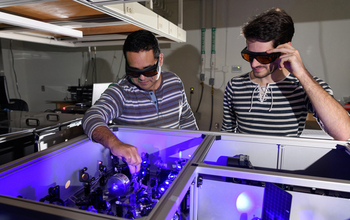Multimedia Gallery
Examining setup to process laser light in visible range
Carlos Silva (left), a professor at Georgia Tech’s School of Chemistry and Biochemistry, and graduate research assistant Félix Thouin examine a setup to process laser light in the visible range for the testing of quantum properties in a halide organic-inorganic perovskite. Silva was co-lead on a recent study where researchers uncovered eccentric physics behind next-generation semiconducting materials' potential to transform lighting technology and photovoltaics.
This research was supported in part by the National Science Foundation (grant DMR 18-38276). Read more in the Georgia Tech news story Semiconductors come from ornate quantum physics. (Date image taken: unknown; date originally posted to NSF Multimedia Gallery: June 20, 2019)
Credit: Georgia Tech/Rob Felt
Images and other media in the National Science Foundation Multimedia Gallery are available for use in print and electronic material by NSF employees, members of the media, university staff, teachers and the general public. All media in the gallery are intended for personal, educational and nonprofit/non-commercial use only.
Images credited to the National Science Foundation, a federal agency, are in the public domain. The images were created by employees of the United States Government as part of their official duties or prepared by contractors as "works for hire" for NSF. You may freely use NSF-credited images and, at your discretion, credit NSF with a "Courtesy: National Science Foundation" notation.
Additional information about general usage can be found in Conditions.
Also Available:
Download the high-resolution JPG version of the image. (3.8 MB)
Use your mouse to right-click (Mac users may need to Ctrl-click) the link above and choose the option that will save the file or target to your computer.



 All images in this series
All images in this series